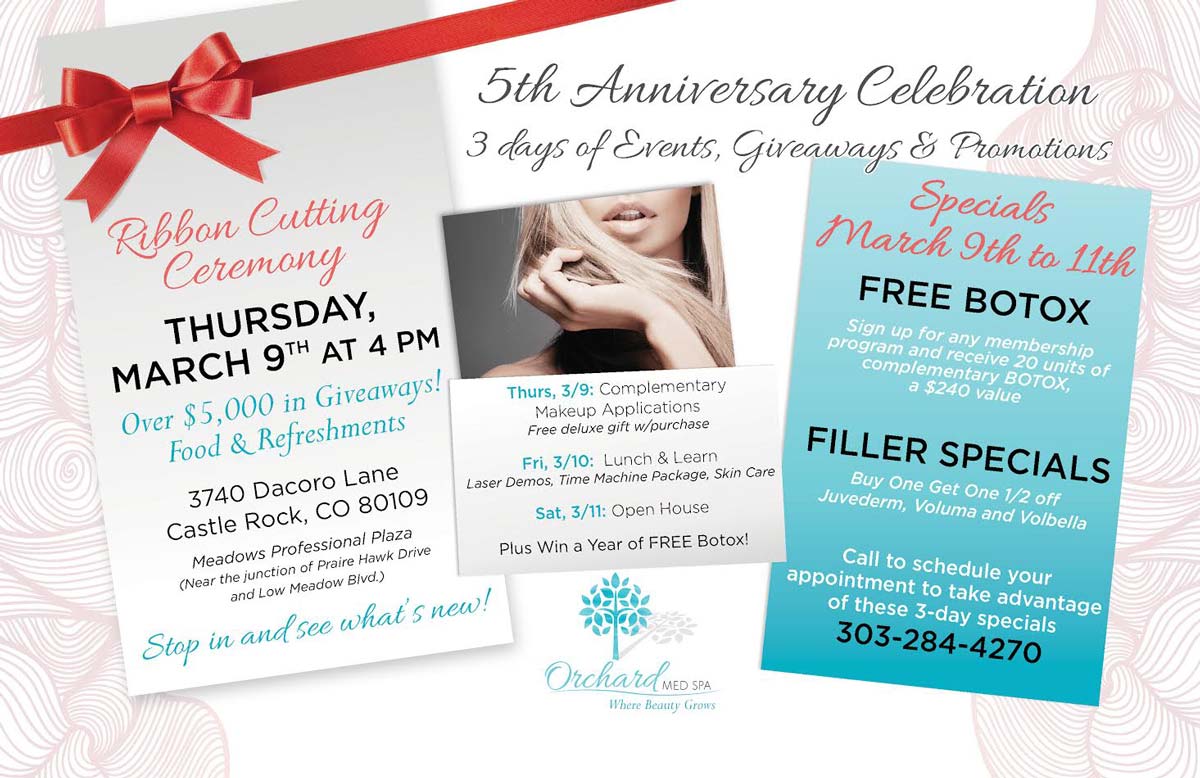5th Anniversary Celebration
Join us for 3 days of Events, Giveaways & Promotions!
Refer a Friend
Ready to earn $50 in services? Fill out your information and your friend's and click 'submit':
[[[FORM_UFAY6PJX]]]Hide Leg Veins
Leg Vein Therapy
Treatment for Leg Veins
Primary options for small and superficial veins on the legs include both laser and sclerotherapy.
Sclerotherapy is a minimally invasive injection treatment for smaller veins called reticular veins and spider veins. (Large varicose veins are generally treated with endovenous laser, a surgical procedure that is performed by vein specialists.)
A special medicine is injected into the vein that causes it to shrink. The inner lining of the vein is injured by the medication action. This messages the body to trigger a natural resorption of the vein. This process can take weeks or months depending on the number and size of the veins present.
Needle phobic? We totally understand. Skip down to laser treatment to see your options.

How many treatments will I need?
Patients will most likely require several treatment sessions to get the best clearance. Veins can recur which will necessitate future treatments. If you already have weak veins, then it stands to reason that new ones could appear over time.
Side effects?
There is a potential for post treatment pigmentation following Sclerotherapy injections. This pigmentation is treated with bleaching cream.
Patient satisfaction
On average, 86% of patients were satisfied or very satisfied with their Sclerotherapy treatments.
Laser Treatment for Leg Veins
Different lasers do different jobs when it comes to veins. For spider veins, LimeLight uses the most advanced intense pulsed light technology for superficial broken capillaries and diffuse redness in the skin. For larger veins we will use the 1064 YAG laser which is capable of treating even large blue veins. The 1064 YAG laser CoolGlide Vein Therapy is a component of the newest Cutera Xeo laser platform.
How does a vein laser work?
Light energy causes the blood within the vein to coagulate. The now nonfunctional vein is seen by the body as unnecessary and it is absorbed by the body. Blood flow is redirected to deeper veins.
Successful vein treatments may require both laser and sclerotherapy to provide the most complete resolution.
Vein laser process
Prior to treatment, your skin is cleansed and you will be given protective goggles to wear. When the laser pulses, you will feel a warming or tingling sensation. The procedure takes anywhere from 5 to 30 minutes, depending on the number of areas treated. A cold compress applied afterward helps calm the skin.
After the treatment your skin will feel warm for several hours. There may be some redness and minimal swelling that can last up to 48 hours. In some cases you may experience a bruise, but this is often a result of taking common blood thinning supplements such as aspirin, Vitamin E, Omega 3 or anti-inflammatories like ibuprofen – best to discontinue use for 7 days prior to having laser treatments.
What are the possible side effects?
It is normal to see redness and some swelling. In some cases, when more aggressive settings are used, you may notice “welts" or “stripes" which develop within the first 24 to 48 hours. This possible side effect can be minimized by frequently applying cold compresses the day of treatment.
If a bruise occurs, this usually disappears in under a week. Vascular laser treatments create few complications when performed by our properly trained providers.
Veins can re-occur and most often multiple sessions are required to get the best clearance. Post treatment pigmentation can sometimes occur despite the most careful treatment. Should this happen, the area is treated with bleaching creams.
How quickly will vein laser treatments work?
The process is gradual and you should expect an average of 2-3 sessions to get the best possible clearance.
FAQ on Veins
What causes spider and reticular veins?
Spider and reticular veins can be caused by many factors.
- Heredity. Having a family member with prominent veins may increase the risk of you developing them. Approximately half of the people who get varicose veins have a family history of them.
- Age. The normal wear and tear of aging may cause valves in the veins to weaken and not work as well.
- Gender. Women are two to three times more likely to develop varicose veins than men. Up to half of American women have varicose veins. Changes in hormones due to puberty, pregnancy, menopause, or taking birth control pills may increase a woman"s risk of developing varicose veins.
- Pregnancy. During pregnancy, the growth of the fetus increases the pressure on the veins in the legs. Varicose veins that occur during pregnancy usually improve within 3 to 12 months following delivery.
- Overweight and obesity. Having extra weight on the body can put additional pressure on the veins.
- Prolonged standing or sitting. This is particularly true with legs bent or crossed. When standing or sitting with legs bent or crossed, the veins have to work harder to pump the blood up to the heart.
- Other possible causes for varicose veins are race, posture, occupation, hormones such as estrogen and progesterone, primary valve incompetence, and incompetent perforating veins.


